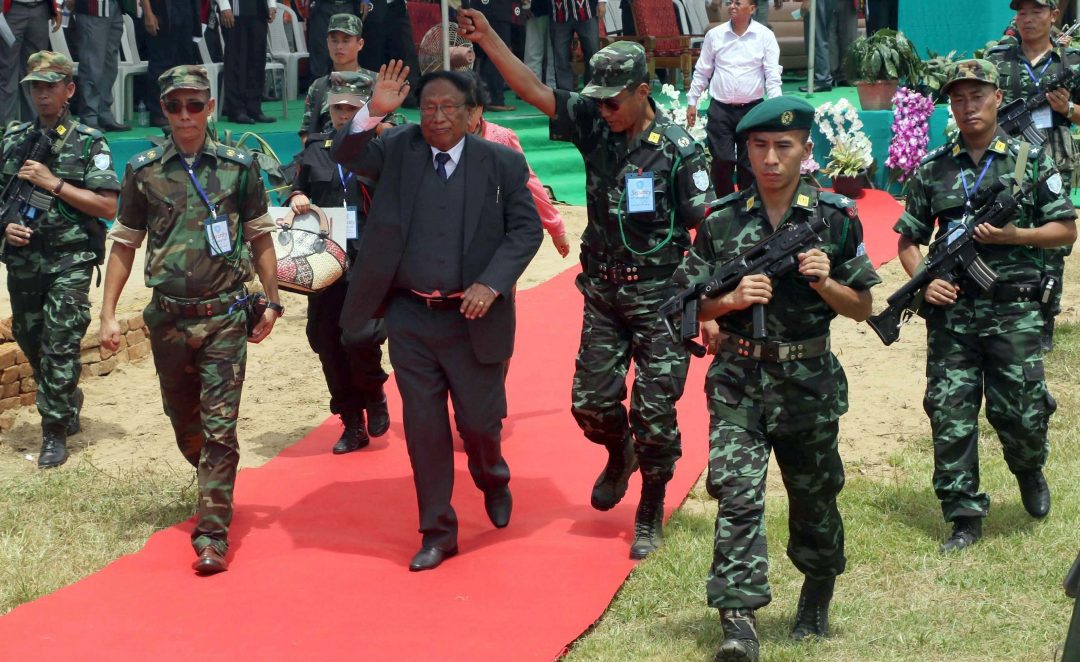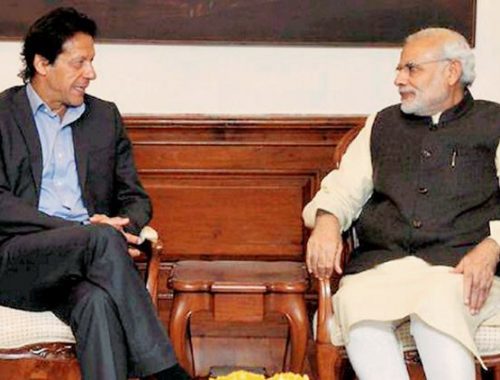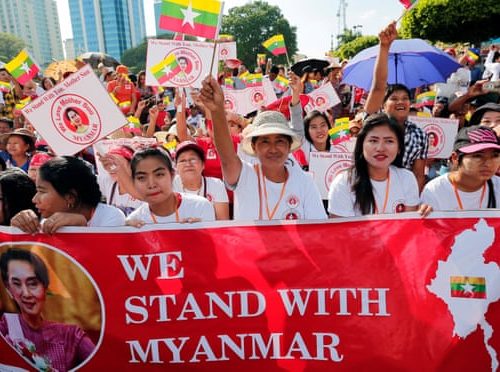Four Reasons Why the NSCN(I-M) Released the Confidential Nagaland Framework Agreement While one reason is definitely to support the organisation’s demand for a new interlocutor, that’s not all there is to it. a By Sangeeta Barooah Pisharoty ———–
New Delhi: In the last six days, the National Socialist Council of Nagalim (Isak-Muivah) has made public the Framework Agreement (FA) – first partially and then a copy of the original – signed with the Narendra Modi government in the presence of the prime minister in New Delhi.
The FA has till now been kept confidential by mutual consent between the government and the organisation “for security reasons”.
So why did the NSCN (I-M) break its promise to the Centre? Particularly at a time when the Centre’s interlocutor for the talks, R.N. Ravi, had said that all important agreements on the peace deal were settled last October and only some minor outstanding issues are left to be sewn up?
It’s clear what the NSCN’s motive is – to strengthen its demand to the Modi government for the removal of Ravi, also the Nagaland governor, as the interlocutor.
Reading the message behind the NSCN (I-M)’s continuous statements, which were particularly aimed at Ravi while praising Modi’s leadership and thereby keeping him (and the government) separate from Ravi (chiefly in the organisation’s press note on August 3 to mark five years of signing the FA in 2015), The Wire had said in an August 3 report that the organisation may be looking for a change of interlocutor. In that press note, the group sought Modi’s intervention in the matter.
In the next two days, it became clear that was the case. The NSCN (I-M) does want a different interlocutor.
And since then, to borrow an NSCN (I-M) phrase used in a press statement on August 16, “a lot of water has flown down the Dhansiri River (the river flows through Nagaland into Assam)”.
The first intention
By making the FA public, the NSCN highlighted that Ravi had “doctored” the original agreement and therefore he might have acted beyond the brief of New Delhi and must be removed for breaking its trust in him. But there is certainly more to it.
I see four clear intentions behind the organisation’s move, particularly when the talks have reached a crucial make or break moment.
One intention is to highlight the trust deficit on Ravi, mainly because he “manipulated” the peace process and how. According to the NSCN, he handed out a different copy of the FA to influential Naga civil society groups (CSOs) that he has been consulting with to get their inputs on the matter, and also the consent to the terms he had set for the peace accord. The original copy was also not shared with the seven Naga National Political Groups (NNPGs), brought later to the negotiating table.
Also read: Could the Home Ministry Bring More ‘Facilitators’ to Break Naga Peace Talks Deadlock?
Thus far, the Naga leaders are divided around the demand for a separate flag and a constitution separate from the Indian constitution. While the working committee of the NNPGs is ready to go ahead without these conditions, the NSCN (I-M), led by its general secretary Th. Muivah, is not.
It must be mentioned here that hardly any peace process conducted by the Centre in the Northeast through Intelligence Bureau officials (Ravi retired as deputy National Security Adviser) ended without creating two sides among the organisations with whom the negotiations were conducted – one ready to accept the government’s terms for the peace accord, the other not quite there.
In the Naga talks too, this is happening. Ravi, highlighting this division, has been giving press statement that it is only one faction that is opposed to the Centre’s terms and delaying the accord.
So, the NSCN, by making public the original copy of the FA, wants to put Ravi in the spot for “craftily” going back on the Centre’s word to the organisation given in the presence of Modi and thereafter creating a division of opinion between the Naga leaders on the terms of the Accord.
It also, at the moment, doesn’t want to hold responsible the Naga leaders for the division of opinion between them, instead making Ravi the sole factor behind it. They couldn’t have acted otherwise, the NSCN is arguing, because Ravi handed out a “doctored” copy of the agreement to them.
This step also keeps the government separate from Ravi, thus keeping a door open to the Centre for further negotiations on the agreed terms. The NSCN, by releasing the original copy of the FA, has checkmated Ravi over how he might have possibly achieved that consent from the other groups.
The original and ‘doctored’ copies of the FA.
The second intention
The second intention behind making the FA public is an extension of the first. By stating that it was only Ravi who “manipulated” the process and that he is a “liability” in the matter, NSCN is attempting to rebuild a consensus among the divided Naga groups over the notion that certain factors were non-negotiable and will continue to remain so. It has thereby also put these groups in a tight spot vis-à-vis NSCN’s position before the public. It has sent out a message to the public that it has not budged from the position of extracting the maximum possible from New Delhi, the reason why it had rejected the Shillong Agreement of 1975 and broke away from the Naga National Council to form NSCN.
In the August 11 statement, it had accused Ravi of misleading the Parliamentary Standing Committee too on its stated position. It mentioned chapter III of the ‘Naga Peace Accord’ index number 3, 1 clause 3.1.4, of the parliamentary report number 213 reading as, “In 2015, the GoI reached an understanding with the NSCN (IM) which agreed for settlement within Indian Federation with special status. The Interlocutor informed the committee that this was a departure from their earlier position of ‘with India’, not ‘within India’ and the GoI called it Framework Agreement and signed it.”
By stating its disagreement to what was stated in the committee report, the NSCN has tried to tell the Naga public that it has not moved on from its earlier position, and it is only NSCN that is trying to get the best deal for the people against all odds. This stated steadfastness of intent can also be read as an attempt to reject Ravi’s endeavour to bring in more stakeholders in the peace process to likely dilute the position of the NSCN as the primary negotiator for peace.
The third intention
The NNPGs and some influential Naga CSOs have reconciled to Ravi’s inability to recognise the existing blue, red and yellow Naga flag and a separate constitution because the government has already done away wit Articles 370 and 35A. Those articles had given the right to Jammu and Kashmir under the constitution to have a separate flag and a separate constitution. The general message since has been that there is no room to seek such a demand from the Centre under the Indian constitution by any other entity. And, the Naga political solution can’t be outside of the Indian constitution.
Already, five years have gone by since 2015 and there is also general fatigue among most Naga groups about the prolonged talks. Better take what is on offer has become their mantra, and don’t hanker for what can’t be granted.
However, the NSCN (I-M), by accusing Ravi of deleting a word ‘new’ from the FA which it has termed to be crucial for the discussions, has turned the tables. In a press note on August 11, issued at Dimapur, the organisation said the word ‘new’ is politically sensitive as it goes on to define the peaceful co-existence of two entities or two sovereign powers. Importantly, the word indicates that the negotiations are outside the purview of the constitution. The NSCN statement said removal of the word ‘new’ “virtually changed the meaning of a sentence in the Framework Agreement”.
The August 11 statement added, “Further, “New relationship” strongly indicates outside the purview of Indian Constitution. When “new” is removed there is room for misinterpreting it as under Indian Constitution.”
So, the NSCN is telling the government that the clauses within the accord need not be within the constitution.
The fourth intention
Additionally, the intention is also to highlight the “shared sovereignty” part of the FA. NSCN has throughout used the term “shared sovereignty” in its dealings with Ravi as the Centre’s interlocutor.
In his address to the Naga people on August 14, which it celebrates as independence day after British rule with its own flag, a day prior to the Indian independence day, Muivah said, “The agreement also says, “Inclusive peaceful co-existence of the two entities sharing sovereign power”.
He said, “By ‘inclusive’ it means all Naga in different administrative units and political camps are to be included in the agreement. Co-existence of the two entities is self-explanatory. It means the two peoples and nations will co-exist. Political and legal experts admit the terms ‘co-existence’ and ‘shared-sovereignty’ apply to two entities, not one entity. The Nagas will co-exist with India sharing sovereign powers as agreed in the Framework Agreement and defined in the competencies. But they will not merge with India.”
In that address, where he explained the Naga peace process under six prime ministers – from Jawaharlal Nehru to Modi – he also questioned the legitimacy of the Nagaland state. It is, however, interesting to note that while the talks with various prime ministers had failed to achieve a solution due to the ‘sovereignty’ demand of the Nagas leaders, the Modi government, hinged on the concept of one ‘strong’ nation, brought them to the table on the promise of ‘shared sovereignty’.
Finally, what must be recognised is that the NSCN, helmed by Muivah, is still a tough negotiator and the Centre can’t possibly depend beyond a point on the same toolbox used on other stakeholders in the region to sign on the dotted line.




